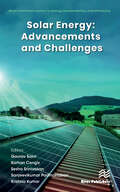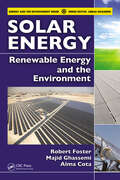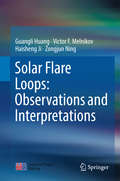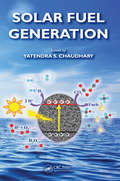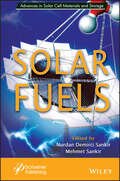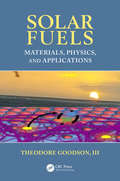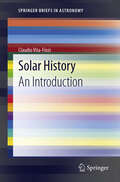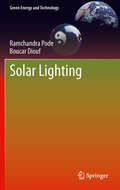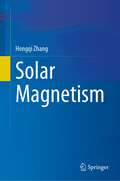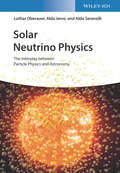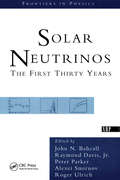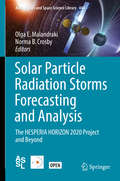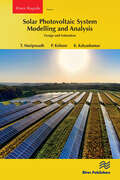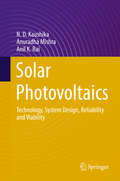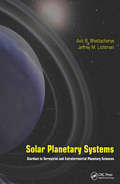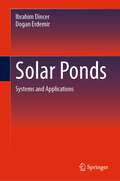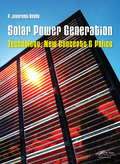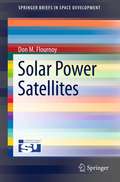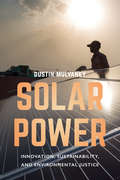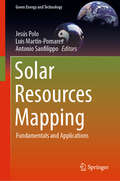- Table View
- List View
Solar Energy, Mini-grids and Sustainable Electricity Access: Practical Experiences, Lessons and Solutions from Senegal (Routledge Focus on Environment and Sustainability)
by Debajit Palit Kirsten Ulsrud Charles Muchunku Gathu KirubiThis book presents new research on solar mini-grids and the ways they can be designed and implemented to provide equitable and affordable electricity access, while ensuring economic sustainability and replication. Drawing on a detailed analysis of solar mini-grid projects in Senegal, the book provides invaluable insights into energy provision and accessibility which are highly relevant to Sub-Saharan Africa, and the Global South more generally. Importantly, the book situates mini-grids in rural villages within the context of the broader dynamics of national- and international-level factors, including emerging system innovation and socio-technical transitions to green technologies. The book illustrates typical challenges and potential solutions for practitioners, policymakers, donors, investors and international agencies. It demonstrates the decisive roles of suitable policies and regulations for private-sector-led mini-grids and explains why these policies and regulations must be different from those that are designed as part of an established, centralized electricity regime. Written by both academics and technology practitioners, this book will be of great interest to those researching and working on energy policy, energy provision and access, solar power and renewable energy, and sustainable development more generally.
Solar Energy: Advancements and Challenges (River Publishers Series in Energy Sustainability and Efficiency)
by Krishna Kumar Gaurav Saini Korhan Cengiz Sanjeevikumar Padmanaban Sesha SrinivasanEnergy is a key source of economic growth due to its involvement as the primary input. Energy drives economic productivity and industrial growth. It can be considered as the prime requirement for the modern economy. Solar energy is a renewable source of energy that can be used to produce heat or generate electricity. The total amount of solar energy available on Earth’s surface is vastly in excess of the world’s current and anticipated energy requirements. In the 21st century, solar energy is expected to become increasingly attractive as a renewable energy source. An increase in the share of solar energy may destabilize the grid. To overcome the issues of grid instability, specifically in remote areas, BIM and GIS-based microgrid planning based on data can be effectively used. BIM and GIS are used to assess alternative solutions and big data analytics in building solar electrical systems according to planning requirements and managing assets. The integration of BIM and GIS information systems for microgrid planning is appealing due to its potential benefits, such as it decreases the microgrid planning time and cost. The present book is about the advancements in technology for harnessing solar energy and the challenges associated with different modes of utilizing this inexhaustible renewable energy source. This book will be helpful for researchers, academicians, technologists, innovators, and industry experts working in the area of solar energy, artificial intelligence, and smart grids.
Solar Energy: Renewable Energy and the Environment (ISSN)
by Robert Foster Majid Ghassemi Alma CotaDrawing on the authors' extensive research and project implementation around the globe, this book provides detailed knowledge for converting solar radiation into a suitable energy supply. It presents technical fundamentals to give a clear understanding of how solar energy can be captured for later use. The authors examine thermosolar collectors, photovoltaics modules, and other important types of solar receivers as well as cover typical cost-effective applications, including water pumping, residential electrification, lighting, small-scale irrigation, and more. Examples, case studies, and lessons learned from technical failures illustrate how to best implement solar energy projects.
Solar Flare Loops: Observations and Interpretations
by Guangli Huang Victor F. Melnikov Haisheng Ji Zongjun NingThis book provides results of analysis of typical solar events, statistical analysis, the diagnostics of energetic electrons and magnetic field, as well as the global behavior of solar flaring loops such as their contraction and expansion. It pays particular attention to analyzing solar flare loops with microwave, hard X-ray, optical and EUV emissions, as well as the theories of their radiation, and electron acceleration/transport. The results concerning influence of the pitch-angle anisotropy of non-thermal electrons on their microwave and hard X-ray emissions, new spectral behaviors in X-ray and microwave bands, and results related to the contraction of flaring loops, are widely discussed in the literature of solar physics. The book is useful for graduate students and researchers in solar and space physics.
Solar Fuel Generation
by Yatendra S. ChaudharyAs the search for renewable sources of energy grows more urgent, more and more attention is focusing on the blueprint offered by biological photosynthesis for translating the energy of our Sun into energy rich molecules like H2 and carbohydrates, commonly known as "solar fuels." These solar fuels have enormous potential to store high densities of energy in the form of chemical bonds as well as being transportable. This book offers a complete overview of the promising approaches to solar fuel generation, including the direct pathways of solar H2 generation and CO2 photocatalytic reduction. Solar Fuel Generation is an invaluable tool for graduate students and researchers (especially chemists, physicists, and material scientists) working in this field.
Solar Fuels (Advances in Solar Cell Materials and Storage)
by Mehmet Sankir Nurdan Demirci SankirSOLAR FUELS In this book, you will have the opportunity to have comprehensive knowledge about the use of energy from the sun, which is our source of life, by converting it into different chemical fuels as well as catching up with the latest technology. The most important obstacle to solar meeting all our energy needs is that solar energy is not always accessible and, therefore, cannot be used when needed. Consequently, the conversion of solar energy into chemical energy, which has become increasingly important in recent years, is a groundbreaking topic in the field of renewable energy. This type of chemical energy is called solar fuel. Hydrogen, methanol, methane, and carbon monoxide are among the solar fuels, which can be produced via solar-thermal, artificial photosynthesis, photocatalytic or photoelectrochemical routes. Solar Fuels compiles the objectives related to the new semiconductor materials and manufacturing techniques for solar fuel generation. Chapters are written by distinguished authors who have extensive experience in their fields. A multidisciplinary contributor profile, including chemical engineering, materials science, environmental engineering, and mechanical and aerospace engineering provides a broader point of view and coverage of the topic. Therefore, readers absolutely will have a chance to learn about not only the fundamentals, but also the various aspects of materials science and manufacturing technologies for solar fuel production. Moreover, readers from diverse fields should take advantage of this book to comprehend the impacts of solar energy conversion in chemical form. Audience The book will be of interest to a multidisciplinary group of fields in industry and academia, including physics, chemistry, materials science, biochemical engineering, optoelectronic information, photovoltaic and renewable energy engineering, electrochemistry, electrical engineering, and mechanical and manufacturing engineering.
Solar Fuels: Materials, Physics, and Applications
by Iii Theodore GoodsonWritten for use as a text and reference for those interested in how new materials may be used to capture, store, and use solar energy for alternative energy resources in everyday life, Solar Fuels: Materials, Physics, and Applications discusses the fundamentals of new materials and the physical processes involved in their mechanisms and design. This book offers clear examples of current state-of-the-art organic and inorganic solar cell materials and devices used in the field, and includes experiments testing solar capability along with standardized examples. Last, but not least, it also gives a clear outline of the challenges that need to be addressed moving forward.
Solar History
by Claudio Vita-FinziBeyond the four centuries of sunspot observation and the five decades during which artificial satellites have monitored the Sun - that is to say for 99.99999% of the Sun's existence - our knowledge of solar history depends largely on analogy with kindred main sequence stars, on the outcome of various kinds of modelling, and on indirect measures of solar activity. They include the analysis of lunar rocks and meteorites for evidence of solar flares and other components of the solar cosmic-ray (SCR) flux, and the measurement of cosmogenic isotopes in wood, stratified ice and marine sediments to evaluate changes in the galactic cosmic-ray (GCR) flux and thus infer changes in the sheltering magnetic fields of the solar wind. In addition, shifts in the global atmospheric circulation which appear to result from cyclic fluctuations in solar irradiance have left their mark in river sediments and in the isotopic composition of cave deposits. In this volume the results these sources have already produced have been summarised, paying special attention to those that reflect processes in different parts of the Sun's interior and that display periodicities and trends which may enable us to forecast future large-scale environmental changes.
Solar Hydrogen Energy Systems
by Paolo Tartarini Gabriele ZiniIt is just a matter of time when fossil fuels will become unavailable or uneconomical to retrieve. On top of that, their environmental impact is already too severe. Renewable energy sources can be considered as the most important substitute to fossil energy, since they are inexhaustible and have a very low, if none, impact on the environment. Still, their unevenness and unpredictability are drawbacks that must be dealt with in order to guarantee a reliable and steady energy supply to the final user. Hydrogen can be the answer to these problems. This book presents the readers with the modeling, functioning and implementation of solar hydrogen energy systems, which efficiently combine different technologies to convert, store and use renewable energy. Sources like solar photovoltaic or wind, technologies like electrolysis, fuel cells, traditional and advanced hydrogen storage are discussed and evaluated together with system management and output performance. Examples are also given to show how these systems are capable of providing energy independence from fossil fuels in real life settings.
Solar Light-to-Hydrogenated Organic Conversion: Heterogeneous Photocatalysts
by Hairus AbdullahThis book highlights the promising photocatalytic methods for synthesizing organic chemicals by simultaneously degrading the toxicity of raw substances used for organic synthesis. It presents various semiconducting materials with high catalytic activities in hydrogen evolution reactions (HERs) and hydrogenation reactions, as well as the material characterizations for identifying semiconductor photocatalysts. The focus is on understanding the hydrogen dissociation and activation of substances in the process of hydrogenation and the fabrication of nanostructured catalysts with desired activity and selectivity. Recent works show photocatalytic hydrogenation reactions with in situ generated H+ on catalyst surfaces utilizing initial chemicals such as nitrophenol, nitrobenzene, azobenzene, and benzene for valorization. In addition, the photocatalytic valorization of waste glycerol is also discussed. Besides the hydrogenation reactions, the reduction of oxygen to form H2O2 can be done with a photocatalytic method in atmospheric conditions. Some related perspectives and outlooks are also discussed for possible future development.
Solar Lighting
by Ramchandra Pode Boucar DioufLimited availability of grid-based electricity is a major challenge faced by many developing countries, particularly the rural population. Fuel-based lighting, such as the kerosene lantern, is widespread in these areas, but it is a poor alternative, contributing to global warming and causing serious health problems. Several developing countries are therefore now encouraging the use of sustainable lighting. Solar Lighting gives an in-depth analysis of energy-efficient light production through the use of solar-powered LED systems. The authors pay particular attention to the interplay between energy transformation and device efficiency. They also discuss diverse aspects of renewable energy, including how an improvement in the efficiency of appliances can reduce the cost of energy. Solar Lighting is written for physicists, environmental experts and lighting engineers. It is also suitable for undergraduate students in the fields of environmental science, electrical engineering and renewable energy.
Solar Magnetism
by Hongqi ZhangThis book highlights fundamentals and advances in the theories and observations of solar magnetic fields. Solar magnetism is an important part of solar physics and space weather research. It covers the formation, development, and relaxation of the magnetic fields in the solar eruptive process. The book discusses topics ranging from measurement facilities for solar observations to the evolution of solar magnetic fields, the storage of magnetic energy, and the magnetic helicity in the solar atmosphere and its relation with solar cycles. The book also presents recent advances in measurements and observations of solar magnetic shear, currents, magnetic helicity, and solar cycles. The book intends for astronomy-majored students and researchers interested in solar magnetism and its role in astrophysics.
Solar Neutrino Physics: The Interplay between Particle Physics and Astronomy
by Lothar Oberauer Aldo Ianni Aldo SerenelliA guide to the fascinating interplay between particle physics and astrophysics that highlights the discovery of neutrino oscillations Written by three international experts on the topic, Solar Neutrino Physics offers a review of the status of solar physics with its strong link to neutrino physics. The book explores constitutive physics and the governing equations of standard solar models. The authors also review the theory of neutrinos in the Standard Model and the related detector experiments. The book contains a summary of the results from various experiments and develops a coherent view of the current state-of-the-art of solar neutrino physics. Solar Neutrino Physics shows how solar models can be calibrated with the observational constraints of the age, mass, radius, and luminosity of the sun. The authors present general evolutionary properties of the sun as a star, past and future. They also discuss the solar neutrino production via the pp-chains and CNO-cycle, including the important role of the chemical composition of the sun. A very important source of information about the solar interior is offered by helioseismology, the study of solar oscillations. This important book: -Presents a high-level overview of the field of solar neutrino physics -Brings together data and their interpretation of results obtained at various solar neutrino observatories -Combines the theory of nuclear reactions with solar neutrino experiments -Contains a review of SNO+, JUNO, LENA, Hyper-Kamiokande, and DUNE. Written for astronomers, physicists, and high energy physicists, Solar Neutrino Physics contains a review of the field of neutrino physics, the relevant equations, and the impact of matter on the behavior of neutrino oscillations.
Solar Neutrinos: The First Thirty Years (Frontiers in Physics)
by Raymond Davis Jr.The papers reprinted in this book depict a research field that is poised to answer some of the fundamental questions of twentieth-century physics and astronomy: How does the sun shine? What is the dark matter? Is there new physics beyond the ?standard model??This book is of interest to students as well as active researchers in the scientific areas spanned by the reprinted papers, which include physics, chemistry, astronomy, geology, and engineering. Historians of science, some of whom have already used the solar neutrino problem as a case study, will also find this collection a rich source of examples and insights.Solar Neutrinos gives one the special feeling of being present at the birth of a scientific field. The physical ideas are presented with a simplicity that is unusual in review of papers. By delving into the scientific landmarks reprinted here, one can see clearly how researchers-starting with a paucity of data and with conflicting hypothesis-struggled together to grope their way to a better understanding of the sun and of weak interaction physics. Three new papers have been added to the present paperback version; these papers represent breakthroughs in the field since the original 1994 hardcopy publication.
Solar Neutrons and Related Phenomena
by Lev DormanThis book presents the first comprehensive compilation and review of the extensive body of experimental and theoretical material on solar neutrons and related phenomena published in the scientific literature over the last sixty years. Phenomena related to solar neutrons are more specifically: - the decay products of solar neutrons - solar gamma rays generated in processes like nuclear reactions between solar energetic charged particles and matter of the solar atmosphere, as well as by the capture of solar neutrons by hydrogen atoms in the solar atmosphere - the propagation of solar neutrons, solar gamma rays and other secondary particles through the solar photosphere, chromosphere and corona, as well as through interplanetary space and through the Earth's atmosphere. Models and simulations of particle acceleration, interactions, and propagation processes show that observations of solar neutrons and gamma rays in space and in the Earth's atmosphere yield essential and unique information on the source function of energetic solar particles, as well as on the chemical composition and density distribution of plasma in the solar atmosphere. The results described in the book may also be useful for astrophysical studies of other stars and different astrophysical objects, as well as for space weather problems. The book will serve as a reference work for researchers and students in solar physics, plasma, neutron, and gamma ray physics, as well as in cosmic ray physics, space science, geophysics and those researching space weather problems.
Solar Particle Radiation Storms Forecasting and Analysis
by Olga E. Malandraki Norma B. CrosbySolar energetic particles (SEPs) emitted from the Sun are a major space weather hazard motivating the development of predictive capabilities. This book presents the results and findings of the HESPERIA (High Energy Solar Particle Events forecasting and Analysis) project of the EU HORIZON 2020 programme. It discusses the forecasting operational tools developed within the project, and presents progress to SEP research contributed by HESPERIA both from the observational as well as the SEP modelling perspective. Using multi-frequency observational data and simulations HESPERIA investigated the chain of processes from particle acceleration in the corona, particle transport in the magnetically complex corona and interplanetary space, to the detection near 1 AU. The book also elaborates on the unique software that has been constructed for inverting observations of relativistic SEPs to physical parameters that can be compared with sp ace-borne measurements at lower energies. Introductory and pedagogical material included in the book make it accessible to students at graduate level and will be useful as background material for Space Physics and Space Weather courses with emphasis on Solar Energetic Particle Event Forecasting and Analysis. This book is published with open access under a CC BY license.
Solar Photovoltaic System Modelling and Analysis: Design and Estimation (River Publishers Series in Power)
by T. Mariprasath P. Kishore K. KalyankumarThis book outlines the global opportunity to increase solar photovoltaic (PV) plant energy yields through modelling and analysis. Because it is endlessly available in Earth’s atmosphere, solar PV energy extraction is rising faster than all other renewable energy sources worldwide. Thus, technological improvements are needed to lower the cost of solar PV per watt every year. Since solar PV efficiency is low, modelling and analysis of boost converters, maximum power point tracing, solar PV cleaners, irradiation tracing systems, and panel tilt adjustments all help increase solar PV plant energy yield.Solar Photovoltaic System Modelling and Analysis covers topics such as: Relevance, types, and growth rate of renewable resources How solar PV systems generate electricity Panel varieties and their importance Solar PV designs and architectures Charge controllers, including the latest technologies Boost converter modelling and analysis in MATLAB The necessity of hybrid power plants (modelling and analysis) Designing a solar PV system including panel selection for a specific application, as well as converter and inverter estimation
Solar Photovoltaics: Technology, System Design, Reliability And Viability
by N. D. Kaushika Anuradha Mishra Anil K. RaiThis book presents a quantitative description of the physics of solar-cell materials, transport processes, fabrication methods, and offers a scientific understanding of the technology involved. It also presents the current knowledge of the electrical characteristics of modules arrays and balance of systems (BOS) for a wide spectrum of applications. It particularly focuses on solar-powered communication systems and building integrated photovoltaic (BIPV) systems, exploring the reliability and viability aspects in detail. The book is of interest to application engineers, practitioners in private and government agencies, as well as graduate and postgraduate students.
Solar Planetary Systems: Stardust to Terrestrial and Extraterrestrial Planetary Sciences
by Asit B. Bhattacharya Jeffrey M. LichtmanThe authors have put forth great efforts in gathering present day knowledge about different objects within our solar system and universe. This book features the most current information on the subject with information acquired from noted scientists in this area. The main objective is to convey the importance of the subject and provide detailed information on the physical makeup of our planetary system and technologies used for research. Information on educational projects has also been included in the Radio Astronomy chapters.This information is a real plus for students and educators considering a career in Planetary Science or for increasing their knowledge about our planetary system.
Solar Ponds: Systems and Applications
by Ibrahim Dincer Dogan ErdemirThis book is about solar ponds for energy storage from various perspectives, including fundamentals, efficiencies, system designs, local applications and details about what have been done in the world in the field of solar ponds for generating energy and storage it for useful purposes.
Solar Power (World About Us)
by Sarah LeveteDescribes Solar Energy, what it is, how we can use it to help protect our planet. for younger readers
Solar Power Generation: Technology, New Concepts & Policy
by P. Jayarama ReddyThis book offers a global perspective of the current state of affairs in the field of solar power engineering. In four parts, this well-researched volume informs about:Established solar PV (photovoltaic) technologiesThird-generation PV technologies based on new materials with potential for low-cost large-scale productionSolar cell technology based
Solar Power Satellites
by Don M. FlournoyCommunication satellites are a $144 billion industry. Is there any space-based industry that could possibly beat that market? 'Solar Power Satellites' shows why and how the space satellite industry will soon begin expanding its market from relaying signals to Earth to generating energy in space and delivering it to the ground as electricity. In all industrialized nations, energy demand is growing exponentially. In the developing world, the need for energy is as basic as food and water. The Sun's energy is available everywhere, and it is non-polluting. As business plans demonstrate its technical feasibility, commercial potential, and environmental acceptability, every country on Earth will look to space for the power it needs.
Solar Power: Innovation, Sustainability, and Environmental Justice
by Dustin MulvaneyIn this important new primer, Dustin Mulvaney makes a passionate case for the significance of solar power energy and offers a vision for a more sustainable and just solar industry for the future. The solar energy industry has grown immensely over the past several years and now provides up to a fifth of California’s power. But despite its deservedly green reputation, solar development and deployment may have social and environmental consequences, from poor factory labor standards to landscape impacts on wildlife. Using a wide variety of case studies and examples that trace the life cycle of photovoltaics, Mulvaney expertly outlines the state of the solar industry, exploring the ongoing conflicts between ecological concerns and climate mitigation strategies, current trade disputes, and the fate of toxics in solar waste products. This exceptional overview will outline the industry’s current challenges and possible futures for students in environmental studies, energy policy, environmental sociology, and other aligned fields.
Solar Resources Mapping: Fundamentals and Applications (Green Energy and Technology)
by Jesús Polo Luis Martín-Pomares Antonio SanfilippoThis book presents methods for optimising the spatial and network configuration of solar radiation measuring stations. Various physical and mathematical models are demonstrated, which together with high quality measurements, provide the essential tools to generate and validate solar resource estimates to improve the mapping of solar resources.Each chapter deals with a specific topic, showing its methodology, and providing examples of how to apply these techniques with reference to current projects around the world. These topics include:· Radiometric measurement campaigns;· Equipment calibration, installation, operation, and maintenance;· Data quality assurance and assessment;· Solar radiation modelling from satellite images and numerical models;· Downscaling and kriging interpolation of solar radiation;· Simulation of electric solar power plant generation;· Solar radiation forecasting;· Applications of solar energy; and· Socio-economic benefits of solar energy.The contributors present the statistical and physical models needed to derive solar radiation from satellite images and numerical models, emphasising the importance of measuring solar radiation accurately. They also show the classical models used to generate synthetic data, clear sky models and ancillary air quality and meteorological data from different input sources.Solar Resources Mapping provides industry professionals with methodologies and tools to build solar irradiance maps for different applications. The book will also benefit students and researchers as it serves as a main technical reference, presenting the basic terminology and fundamentals for solar resource mapping that include methods for assessing measurement uncertainty.

